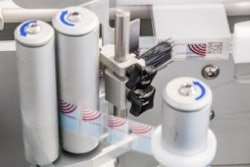Bricolage, Inc. of Grove City, OH, competes in the pressure-sensitive label market by finding added value for its customers. One such customer, Health Care Logistics of Circleville, OH, is a distributor that sells rolls of pressure-sensitive labels to hospitals, clinics, and other healthcare institutions, where healthcare professionals manually remove the labels from a release liner and apply them to vials, syringes, IV bags, etc.
In 2015 Bricolage found value for Health Care Logistics by offering roll labels in a new thermoformed package called Click It Clam™. Unlike the white chip board carton that it replaced, it’s transparent vinyl, so busy nurses and other healthcare professionals can quickly and easily know what label is inside. The plastic package also protects the roll labels better. And when it comes to dispensing, there’s no comparison.
“The chip board carton was not robust enough once in use in the healthcare facilities,” says Jeff Hill, Director of Manufacturing for Bricolage. “A label would get caught inside and roll back, so the nurse would have to pull it out, which sometimes caused the carton to tear.”
Desirable as these customer benefits might be, the new package, which is thermoformed by Jamestown Plastics, also brings significant benefits to Bricolage’s own packaging operations. Previously, Bricolage employees would go through a multi-step process that started by folding together the chipboard carton. Next they’d drop in the roll of labels. Then they’d tuck in lid flaps. And finally, they’d peel off the first label from the roll to slap it on the outside so that the end user would know what’s inside.
With Click It Clam, packaging line operators simply drop in the printed roll of labels and close the lid while listening for the audible click to know the package is shut. “They don’t even have to really watch what they are doing a lot of the time because they can hear it,” explains Jay Baker, the inventor of Click It Clam and the president of thermoformer Jamestown Plastics.
The patented technology is centered on a button closure that produces an audible click sound. There’s a pin or formed protuberance on the lid sidewall of the clamshell. This snaps into a hole on the vertical sidewall of the base. Once in place, it is virtually impossible to distort or break the pin. To reopen the package, the user pushes a small tab formed in the base flange. This deflects the sidewall inward and releases the pin—all with a small amount of pressure. To reclose the lid, the pin deflects the inner sidewall, and the pin seats between openings in the base sidewall and inner wall with a click. The clamshell’s geometry doesn’t allow the interior wall to deflect inward.
A key feature of the Click It Clam is a slot through which the labels are dispensed. Should the roll labels roll back into the container, all the user has to do is push down on the tab with one hand, pull out the roll again, then click the lid shut.
“When we received the samples we knew we had to switch to Click It Clam™,” says Bricolage’s Hill. “It was a no brainer.” Its sturdiness and durability means that, unlike in the past, the dispenser will not lose its integrity. And there’s no chance of the dispenser collapsing or compressing. In fact, Click It Clam™ is stackable, which saves space in storerooms small and large.
Upfront investment
Baker adds that while both Bricolage and Health Care Logistics enjoy the advantages of Click It Clam, Jamestown Plastics incurred hefty capital expense in order to produce it. They also had to design the thermoforming machinery and then engineer and build it. “We moved fast,” says Baker.
There were several challenges that the tooling designers had to overcome. To produce the patented lock-and-release mechanism, the design team had to design and manufacture the necessary components to allow precise timing and speed control over the movement of the apparatus that allowed forming the pin, while still allowing the formed parts to be ejected from the tool cavity when retracted. The team then designed and built a proprietary punching assembly that allows the hole in the sidewall to be punched inline while the parts are still in the web—without any impact on cycle time. The punching assembly was designed to be modular in nature so that it can quickly be reconfigured during a changeover to a different size/style Click it Clam™. All of the necessary components for the actuation assembly for the pin, as well as the punching assembly, were designed and built in-house and then seamlessly integrated onto Jamestown’s inline machines.
Durability demo
To demonstrate Click It Clam’s strength and durability, Baker had Jamestown Plastics employees fill the clamshell with pennies and drop it from a 25-ft roof. It did not open no matter how many times it was flung from that height. In another informal drop test, two pounds of drywall screws were dropped from the roof with the same result.
Klöckner Pentaplast is the exclusive supplier of the 30-gauge Pentaform® vinyl film used in thermoforming Click It Clam. “The design of the lock interface requires human interaction. A human must deliberately release the pin,” explains David Shelton, business manager for thermoforming films at Klöckner Pentaplast
“The thicker or higher the gauge of our Pentaform® vinyl film, the stronger the package for heavier-weight contents,” says Shelton. “Vinyl film, by its nature, has high impact resistance, a wide performance range, and ease of cutting, and it’s easily formulated for a number of applications. That’s beneficial because Click It Clam™ is adaptable, formable, and scalable for applications.”
So diverse are the applications for Click It Clam that it has its own website, www.clickitclam.com, where consumers can purchase empty Click It Clam™ containers retail for use in the home as an incredibly handy storage container. Baker adds that many of his employees have organized their work areas with stackable Click It Clam™ containers of varying sizes and film gauges.
Click It Clam’s original patent was issued in April of 2015, but there’s been a continuation of innovative patents issued or to be assigned in the near future. As mentioned, Klöckner Pentaplast is the exclusive supplier of Pentaform® rigid vinyl film used to produce Click It Clam™. Says Baker, “We’ve been doing business with Klöckner Pentaplast since the mid-1970s. We use a lot of their film because they have a wide breadth of variety.”
“It’s all about developing packaging solutions that correctly marry the product to the expectation,” says Klockner’s Shelton. “Other polyester films such as PETG, RPET, or APET can be used to make Click It Clam™. But the clarity of Pentaform® vinyl film is aesthetically pleasing for a container that will be reused over a long period of time. It has the inherent strength to stand up to ongoing durability demands.”























